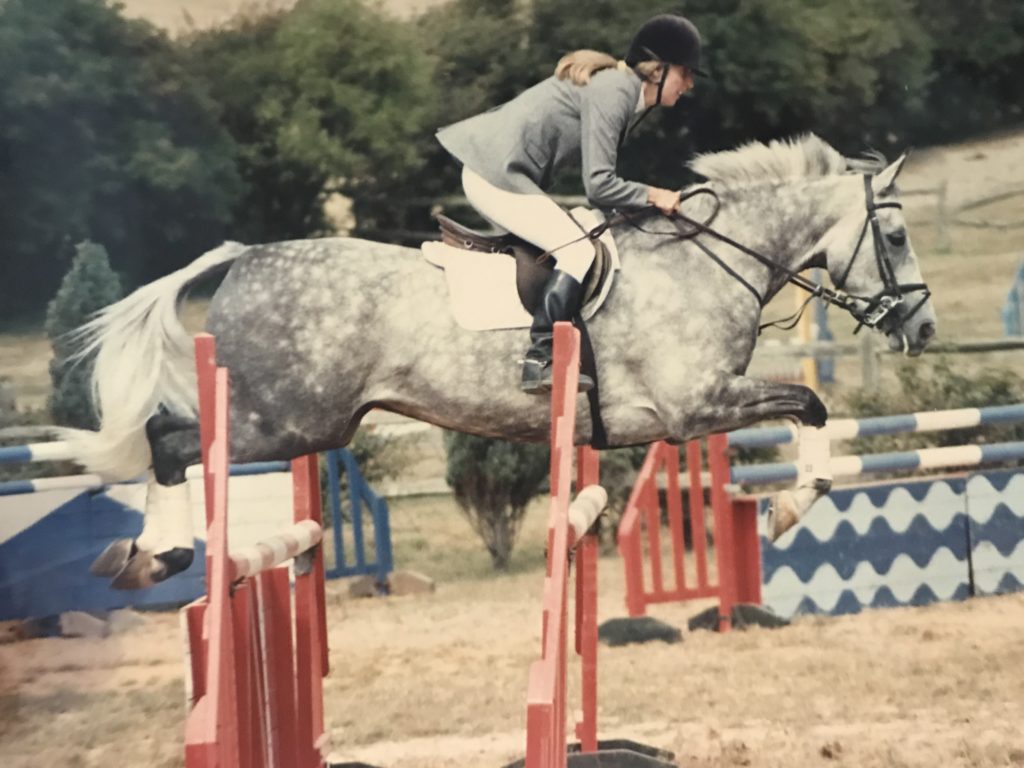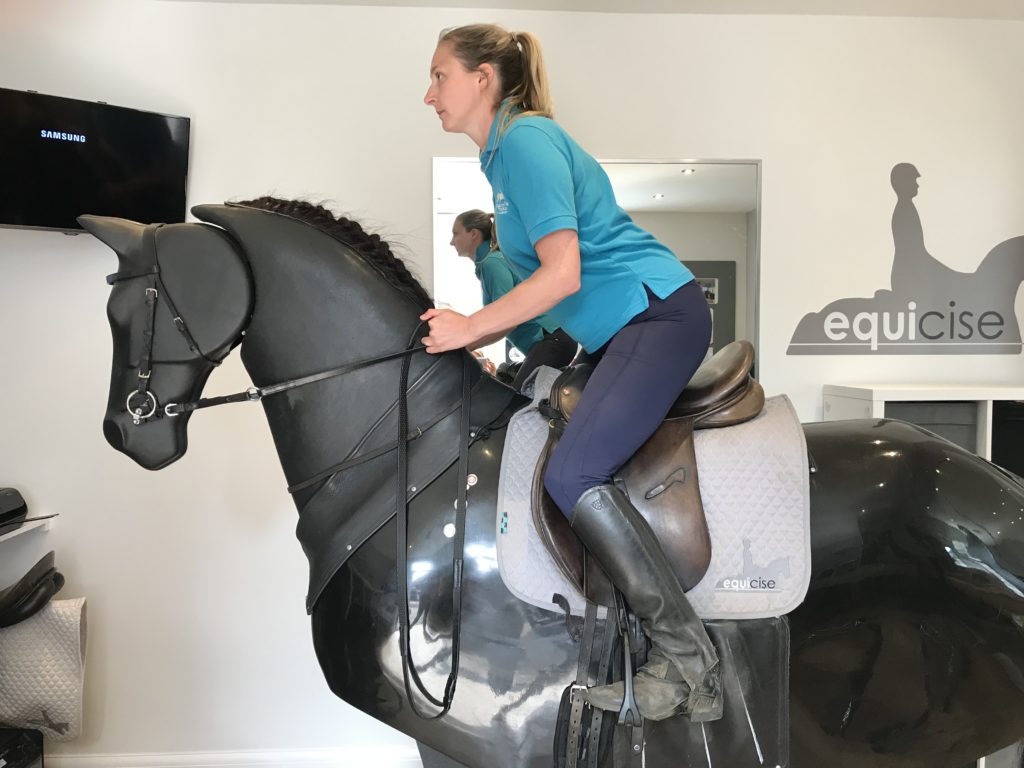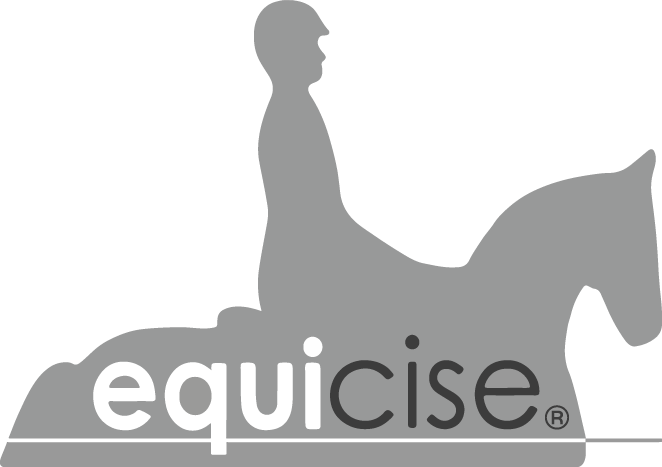30 May 21. Jumping Position
 Every rider who aspires to being good at jumping knows that only by achieving the best possible position will the horse be able to produce its optimum performance in the approach to, over and after each fence. An unbalanced rider, on the other hand, will not be able to follow the horse’s movement over the jumps. You need to be balanced over the centre of the saddle and over your horse’s centre of gravity, helped by flexibility in your ankle, knee and hip joints, all of which act as shock absorbers. If you are in the correct position, there will be a straight line from your shoulder, through your elbow and your knee and down towards the ball of your foot. There should be some room between your body and your horse’s withers, with your head centred, looking up and forward.
Every rider who aspires to being good at jumping knows that only by achieving the best possible position will the horse be able to produce its optimum performance in the approach to, over and after each fence. An unbalanced rider, on the other hand, will not be able to follow the horse’s movement over the jumps. You need to be balanced over the centre of the saddle and over your horse’s centre of gravity, helped by flexibility in your ankle, knee and hip joints, all of which act as shock absorbers. If you are in the correct position, there will be a straight line from your shoulder, through your elbow and your knee and down towards the ball of your foot. There should be some room between your body and your horse’s withers, with your head centred, looking up and forward.
There are a number of risks to jumping if you are in an unbalanced position: you could lurch forwards or backwards when the horse takes off or lands and are likely to need to rely on your hands to balance, pulling on your horse’s mouth and, quite likely, landing heavily in the saddle. As you can imagine, this will seriously affect your horse’s jumping ability and might also cause you to fall off. There are a number of ways to assess if you have mastered balance: if you need to grip with your knees or calves or lock your knees or ankles, you have not. If you use muscular tension to keep your position, you have not, as it will be impossible for your joints to open and close flexibly which is necessary to allow your horse to make an arc over the jump and to absorb the shock of landing. By contrast, if you are a balanced rider, you will automatically give with your hands, but maintain rein contact and follow the contraction and extension of the horse’s head and neck through the take off, over the fence and when it lands, while your elbow and shoulder joints will remain flexible. If you are a more novice rider, you can help maintain your balance by resting your hands against the horse’s crest, so long as you don’t pull on the reins. This does not, however, mean placing all your weight on the horse’s neck, but just enough to keep your hands steady and ensure you don’t jab your horse in the mouth.
So having agreed that balance is important, we should consider what we mean by the correct jumping position. There are two positions that you need to be aware of: the three point seat (typically used for show jumping) and the two point seat (more applicable for cross country).
The three point seat is so called because it involves three points touching the saddle: your pubic bone and both your seat bones, a position made possible by the shorter stirrup length that you will have adopted before jumping. This light seat position will ensure that your shoulders are in front of your hips, whereas the two point position requires you to hold yourself above your horse’s back — just hovering over the saddle — using only the inside of your knees (closing your legs round the horse from the back of your knee and through your calf) and engaging your abdominals, with no other support (ie not relying on your reins or stirrups). In the three point position, the slight curve at your waist enables you to move with your horse as it jumps, ultimately shifting to a two point position at the top of the jumping arc.
You should not attempt to jump unless you are able to achieve and sustain strong and stable three and two point positions as otherwise you could be compromising your safety and also risking injury to your horse if your lack of balance has an impact on his legs and joints on landing. Lessons on the EQUICISE are an excellent way to achieve the perfect jumping position. As is the case with many of the exercises we have discussed in previous articles, the EQUICISE allows you to improve your technique without worrying about your learning process proving an uncomfortable experience for your horse. You can develop a better jumping position by working on keeping your hips, knees, and ankles relaxed and flexible so you will be able to close them as your horse makes an arc over the jump and open them again on landing. You can check whether you are able to sustain a jumping position without relying on the reins for balance, thanks to the feedback from the EQUICISE’s rein sensors. Another major benefit of the EQUICISE is that it allows you to monitor a variety of aspects of your riding that would not be possible on a real horse. For example, you can practise riding in canter for extended periods, using the mirrors on either side to check your position, while the leg sensors will show if you are gripping with your legs or if your lower legs are unstable. Your EQUICISE instructor will be able to help you work through a range of very useful exercises — some more challenging than others — to reinforce your position. Improving your balance and strengthening your position will ensure you feel much more secure and confident over fences and will also lead to a dramatic improvement in your horse’s jumping performance.
If you are seeking to improve your jumping performance, book a JUMPING POSITION LESSON on the EQUICISE and give yourself the best chance of a great experience.
PRACTISE THIS ON THE SIMULATOR

PRACTISE ON THE SIMULATOR, SWITCHING FROM NORMAL SEAT FOR SIX STRIDES TO JUMPING POSITION FOR TWO STRIDES, REMEMBERING TO OPEN YOUR ELBOWS AS YOU GO FORWARD IN THE JUMPING POSITION AND CLOSE THEM WHEN YOU 'LAND'. YOUR LOWER LEG MUST STAY COMPLETELY STILL, WITH WEIGHT IN THE HEEL. HOLD THE JUMPING POSITION FOR APPROXIMATELY A MINUTE AT A TIME AND FEEL HOW THIS MAKES YOUR LOWER LEG EVEN MORE STABLE, WHILE AT THE SAME TIME CONCENTRATING ON KEEPING YOUR HANDS LIGHT BUT WITH A CONTACT. A GREAT WORKOUT FOR YOUR ABS AS WELL AS YOUR LEGS!
PRACTISE THIS ON THE SIMULATOR

PRACTISE ON THE SIMULATOR, SWITCHING FROM NORMAL SEAT FOR SIX STRIDES TO JUMPING POSITION FOR TWO STRIDES, REMEMBERING TO OPEN YOUR ELBOWS AS YOU GO FORWARD IN THE JUMPING POSITION AND CLOSE THEM WHEN YOU 'LAND'. YOUR LOWER LEG MUST STAY COMPLETELY STILL, WITH WEIGHT IN THE HEEL. HOLD THE JUMPING POSITION FOR APPROXIMATELY A MINUTE AT A TIME AND FEEL HOW THIS MAKES YOUR LOWER LEG EVEN MORE STABLE, WHILE AT THE SAME TIME CONCENTRATING ON KEEPING YOUR HANDS LIGHT BUT WITH A CONTACT. A GREAT WORKOUT FOR YOUR ABS AS WELL AS YOUR LEGS!




